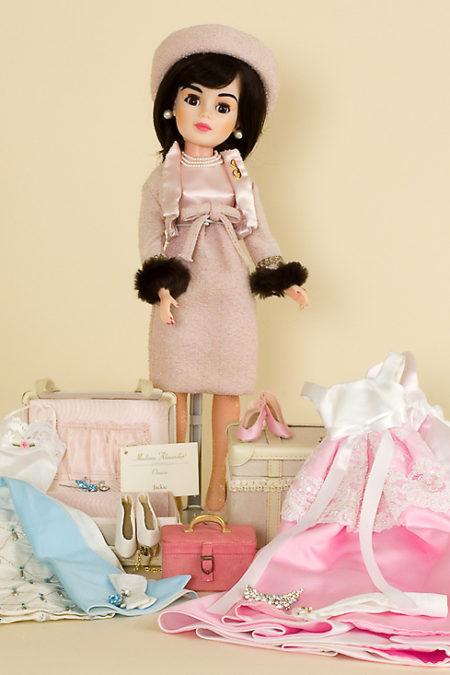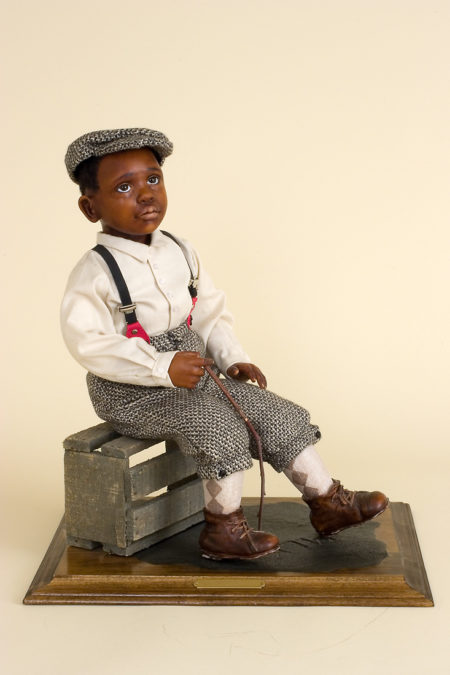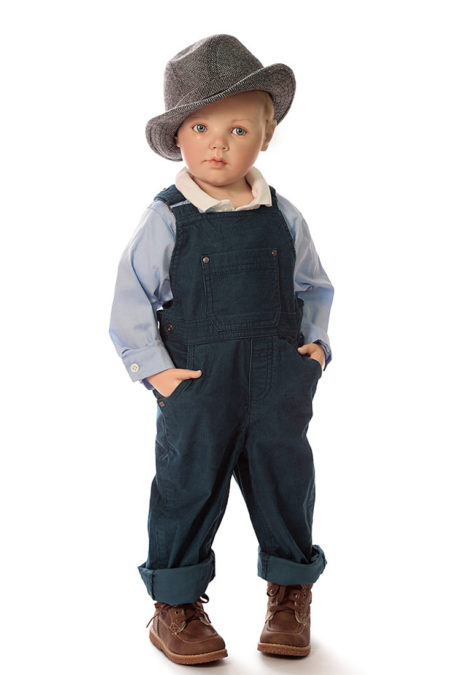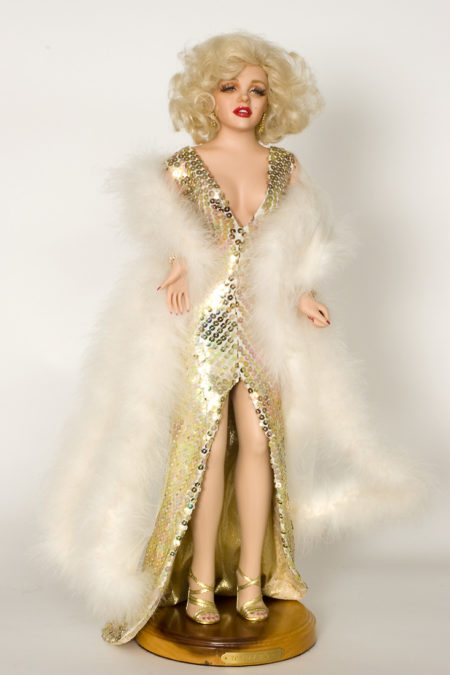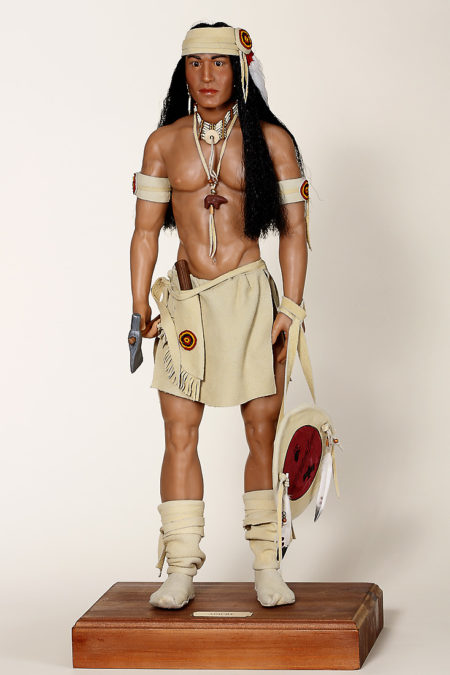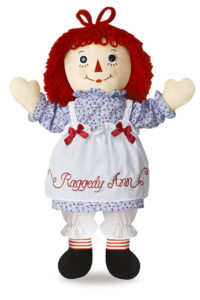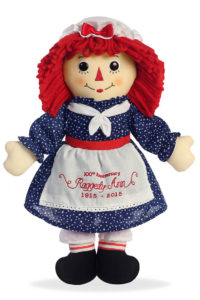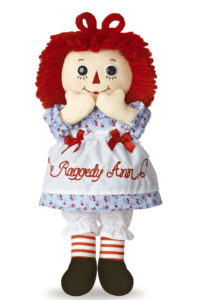If you were asked to choose, what doll would you recommend as the quintessential American doll?
An American Doll as Cultural Icon
Mattel’s Barbie doll, which came into being in 1959, is perhaps the most widely recognized American doll, but for all of her curvatious chic, does she win the Ms. American Doll crown?

American Barbie’s precursor is the post WWII German bombshell of a doll, Lilli, who came on the European scene in 1952. Designed to be svelt and worldly, and not even intended for young girls, Lilli expressed the moral exhaustion of a defeated post war nation. The frustration of economic deprivation was expressed in the overtly materialistic Lilli character. Barbie was conceived by Ruth Handler, after she observed the Lilli phenomenon in Germany, for a post WWII American consumeristic market. Handler convinced Mattel to remake and rebrand the Lilli concept for the American consumer. The full figured, fully mature Barbie doll, (named after Ruth Handler’s daughter, Barbara, and debuting in 1959), was the elephant in the marketplace of traditional baby dolls, but she managed to command her corner and to be accepted as an appropriate play doll and even role model for little girls. . . at least among large numbers of consumers. With her black and white bathing suit, extreme dimensions, and heavily made up side glance . . . not to mention her enviable wardrobe and accessories, and, of course, sometimes boyfriend Ken (named after Ruth Handler’s son and making his debut in 1961) 11.5 inch all body vinyl Barbie was ambitious, active, refreshing, fun-loving, materialistic and seductive — only more “innocently” so than Lilli. What made her fascinating then continues to fascinate today . . . and what made her an enigma and even objectionable then, continues to cause disdain and objection. But to our point, love her or leave her, Barbie is not really like many American woman at all. To a little girl, she is more fantasy than preparation for womanly responsibilities. She’s American, but isn’t really rooted in the spirit of America. She’s a product of the disenchantments and booties of a post war era. She’s a beauty queen, but she may not be our best choice for the Ms. American Doll crown.
Dolls Representing American Historical Figures
We could turn our attention to dolls which are likenesses of American historical personalities — famous Americans depicted in doll form. Consider, for example, 21 inch all vinyl body Jackie “O” produced by Madame Alexander, dressed in the iconic pillbox hat ensemble which she wore the infamous day her husband, President John F. Kennedy, was assassinated in Dallas — an image indelibly etched in the minds of pretty much all Americans of thinking age, even in this day of diminished historical cognizance. This doll is certainly immediately identifiable as an American First Lady — actually, the American First Lady. She is a distinctively American doll, no question about it, and a highly desirable one, both as a doll collectible per se and as an historical depiction. She is perhaps a viable candidate for the office of Ms. American Doll.
Nor can we forget male figures, as for example, Katrina Murawska’s 17 inch one of a kind depiction in polymer clay of Martin Luther King as a boy, scratching his initials in the soil at his feet. Entitled “A Tribute”, this poignant backward glance at an ordinary moment in the early life of a truly extraordinary American leader, destined worthily to be honored for all of America’s days, obviously deserves to be considered among the best examples of an American Doll.
Dolls Representing American Entertainers
But we could as well proffer many other doll likeness of famous Americans from all facets of American life, including some who have obtained worldwide entertainment celebrity, as for example Marilyn Monroe in this extremely limited edition porcelain piece by Marilyn Houchen, entitled Totally Blonde.
Celebrity dolls are their own genre, and the list of them is very extensive. Added most recently to this genre is the 32 inch wax over porcelain very limited special edition for 2015 Elvis Presley the 2 Year Old Boy, done by the current premiere German doll artist, Hildegard Gunzel.
Native American Dolls
Apart from personages that form the fabric of American history and industry, we might also consider a “first American” doll to be most expressive of America, i.e., a doll of a person rooted to the land itself and its indigenous people.
Paulette April’s stunning Princess Fawn is an authentically clad 28 inch porcelain soft body one of a kind ethnic American Indian art doll. She is in a very real respect already crowned queen of authentically American dolls.
Or what about Sherry Housley’s imposing 24 inch very limited resin Apache. Does he not represent well the American spirit of independence, even defiance, and manly courage?
A Folk Art Doll Expresses American Spirit
Our historical dolls and our ethnic American dolls have much to commend them for title of Ms./Mr. American Doll. But they share one common disqualifying feature. In each of these candidates, the medium of doll art itself, although very relevant to their value as art, is not essential to what they convey about America. These dolls may represent deeply significant and quintessential American personages or ideas, and they may be ranked among the prime most examples of doll art, each in its proper category, but none of them is the quintessential American doll – a doll which would capture something essential of the broad underlying spirit of America, would be rooted somehow in the place, and at the same time be nothing in itself if not a simple doll.
The humble Raggedy Ann, that beloved folksy moppet head rag doll, was designed by Illinois born Johnny Gruelle and patented in 1915. Her genesis seems traceable to an old forgotten hand stitched rag doll which was retrieved from the Gruelle family’s attic.
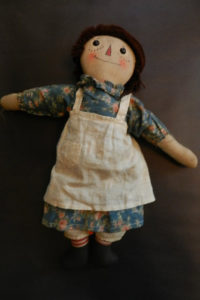
Apparently this original rag doll had been handmade by Johnny’s mother for one of his siblings. Whatever that case may be, in some sense, Raggedy Ann had always been with us — somehow “indigenous” to the place, and even more essentially American than that, she has roots deep in the family. Johnny was a gifted storyteller and cartoonist, and he saw in that little cherished raggedy doll that somehow had always been a part of him and his family, the tale of a truly American doll and the stuff of an American legend. The story of Raggedy Ann, of course, begins with a little girl named Marcella, the name of his own daughter, who stumbles upon a rag doll in her grandmother’s attic. . .The first Raggedy Ann dolls were hand-stitched in the house of the Gruelle’s. It is said that those first dolls had a candy heart sewn in — one which said “I Love You”. No one knows now if this is true. No original doll has been found with the vestiges of actual candy sewn in. But there is no reason to find it implausible. After all, the sweetness of the kind Raggedy Ann must have its source in her heart . . .
America is a great nation because Americans are good, it was once observed. I like to think it still true. So let’s put it all together. Raggedy Anne’s got it all! She has always been in this place, and she’s rooted in family. She has a goodness which flows from a loving heart. And she is nothing if she is not a doll. And one more thing — she’s usually wearing Red, White and Blue! Do you agree that Raggedy Ann should wear the crown of Ms. American Doll?
AND THE WINNER OF THE MS. AMERICAN DOLL Crown . . . the incomparable RAGGEDY ANN!
In 1918, the Raggedy Ann Stories of the adventures and doings of the moppet head rag doll were published by the P. F. Volland Company. In 1929, the character of Marcella herself became the protagonist in the volume of her own tales called “Marcella: A Raggedy Ann Story”, which was a tribute to Johnny Gruelle’s beloved daughter after her untimely tragic passing at the tender age of thirteen. In 1920 the lovable Raggedy Andy appeared, brother of Ann and clad in a sailor suit and hat. Eventually the Camel with the baggy knees, the Hobby Horse and Grandpa Hoppergrass were woven into the tale.
The original Raggedy Ann dolls had brown, not red, yarn hair, tin or wood button eyes, and were made of cloth. The earliest ones bear the mark Patented Sept. 7, 1915. They were made of cloth, had a thin triangular nose, and the eyelashes were painted far below the eyes. Some had sewn knee and elbow joints. Most also had striped socks, a print dress and a white pinafore.

After the first few Raggedy Ann dolls were made in the home of the Gruelles, the Raggedy Ann doll was manufactured for Volland by the Non-Breakable Toy Co. of Muskegon, Michigan, and then by Volland itself, from 1920 until 1934-35, when The Exposition Doll and Toy Co. produced them. This production was very short lived and a find from this manufacturer is rare and valuable. The production passed through other manufacturers, including eventually Applause Toy Co./Russ Berrie (1981) and Hasbro/Plaskool, (1983), down to the present license holder of the plush line since 2012, Aurora World Inc.
On March 27, 2002, Raggedy Ann was inducted into the National Toy Hall of Fame.
Sources: varied


